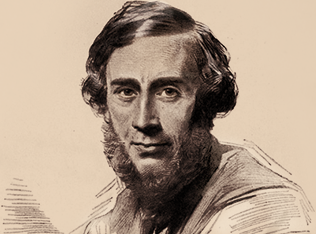Who was John Tyndall?
John Tyndall (1820-1893) was one of the most influential scientists of
the second half of the nineteenth century. The Anglo-Irish successor to Humphry Davy and Michael Faraday as Professor of Natural Philosophy at the Royal Institution (1853-1887), Tyndall was a prominent member of London scientific and social elites. His flamboyant lecturing style, honed by teaching science at private secondary schools, made him a highly sought-after public speaker both in the UK and abroad. He had a Promethean personality: as a young man he was fired as a government surveyor because he led an embarrassing campaign to reveal corruption at its highest levels; soon thereafter he resolved to study for a PhD under Robert Bunsen in Marburg despite not knowing any German. With biologist T. H. Huxley, philosopher Herbert Spencer, botanist J.D. Hooker, and five others, Tyndall was part of the “X-Club”, a group formed in 1864 that sought to direct the course of British science and which actively lobbied for increased government support.
Tyndall is perhaps most famous for arguing that only naturalistic explanations should figure in science, and that theistic explanations therefore had no role to play. This was part of a larger drive to ‘professionalize’ science – by creating a world in which there would be no more priest-scientists with awkward dual allegiances. With his fellow X-Clubbers and other intellectuals he defended Darwin and attacked various critics of scientific naturalism. In this vein he is most often remembered for his Presidential Address to the British Association for the Advancement of Science at its 1874 Belfast Meeting. In this infamous “Belfast Address” he not only praised Darwin’s work but further declared that men of science “shall wrest from theology, the entire domain of cosmological theory,” and that any rival explanatory scheme to science must “submit to its control.” Scandalized Christian opponents responded in pamphlets and journal articles in a controversy rivaling earlier disputes over the Origin of Species. By making Tyndall’s correspondence more accessible we hope to shed more light on the emergence of evolutionary naturalism, the growth of science’s cultural authority, and the rise of a perceived division between “Science” and “Religion.”
John Tyndall combined his glacier researches with mountaineering, at which he became expert. He narrowly missed being the first person to summit the Matterhorn (he was third), and made numerous other difficult climbs throughout the Alps. Mountaineering gained the status of a sport partly because of his popular narratives, including his Glaciers of the Alps (1860) and Hours of Exercise in the Alps (1871). Indeed these mountaineering accounts appeared alongside science works he wrote for a non-specialist audience, such as Heat Considered as a Mode of Motion (1863), On Sound (1867), Researches on Diamagnetism and Magne-Crystallic Action (1870), and Fragments of Science for Unscientific People (1871). Tyndall’s mountaineering and scientific work were intimately connected, and his correspondence will better explain the scale of this relationship.
Despite his great fame and fascinating life Tyndall is not as well known as other X-Clubbers. This is partly because of the macabre nature of his death in 1893 and subsequent events. Plagued by insomnia since middle age, Tyndall was poisoned by his wife Louisa when she accidentally gave him an overdose of sleeping medication. As she and the attending doctors feverishly searched for ways to counteract the chloral, Tyndall allegedly said “Louisa, you have killed your beloved John”, then died. This only further plagued Louisa’s conscience, which she tried to salve by envisioning a grand Life and Letters for her dead husband. She dedicated the rest of her life to this undertaking but had trouble delegating tasks on such an enormous project, and so no such work had appeared by the time of her death some 47 years later. When the definitive Tyndall biography was published by A.S. Eve and C.H. Creasy in 1945, it was met with a yawn as few members of his generation remained and younger people reacted against such memorials of eminent Victorians. Yet a great deal of his correspondence and manuscripts survive, providing fascinating resources not only for those interested in Tyndall’s life and personality, but for people studying the changing relationship between nineteenth-century science and society.



